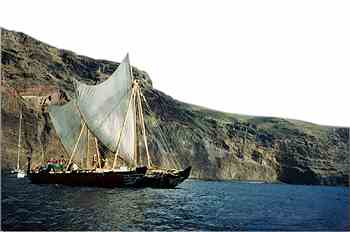Preservation and spreading of unique maritime knowledge and traditions.
One of the major questions which arises from studying the cultural history of Polynesia is how the islands situated in the large Polynesian area in the Pacific was populated. There is no doubt that the Polynesians must have sailed; but how ? In what ships, what were their knowledge and which sailing routes did they use to make such long voyages in early times?
One thing is for sure; the Polynesians was very capable navigators. Until just a few decades ago, long voyages between the islands in primitive ships without the use of navigational instruments were carried out. The knowledge which has made these achievements possible have been extremely comprehensive and it shows an outstanding ability to understand and make use of nature`s possibilities. When talking about identity crises in eastern Polynesia today it is partly because of the loss of connection to these nautic traditions and with these the selfconciet and proudness that is connected with them.
All knowledge has not disappeared though. Through the last 20-25 years small groups of people have carried out intensive research to collect the excisting knowledge and with a headquarter on Hawaii the Polynesian Voyaging Society (PVS) has now detailed education programmes in traditional navigation. A problem with the training in practical seamanship because the lack of ships is pressing though.
Ara-Moana`s primary function in Polynesia is to give possibilities for the training in practical traditional navigation with the activities and rituals connected to this.
International understanding and cultural exchange
Ara-Moana is built in Denmark in the facination of the Polynesian culture. The planning of the use of the boat in Polynesia is carried out in cooperation between the project group and cultural and maritime organizations in Polynesia. In this way the project is Danish/Northern and Polynesian. Cultural exchange is the other and very important part of the project.
Including the skipper Ara-Moana has space for 10 crew members, 5 Scandinavians and 5 Polynesians. In comparysin with modern standards of comfort Ara-Moana is very primitive. The sleeping/living quarters are limited to two narrow cabins each shared by 5 persons. No toilets or showers are available on the boat and water is kept in barrowls. The deck area on the other hand is as large as 130 square meters and gives more than suffient space for training activities. Again the number of crew members on deck is sufficient to challenge the social needs and limits of each crew member.
Most possibly the boat and its physical enviroment will help break down cultural barrieres between the crew members and in this way make the possibilities for the developing of a mutual understanding of the project.
Ara-Moana a cultural forum
The profile the project aims at obtaining, through a combination of training in traditional navigation and cultural exchange, is about viability at several levels. To navigate without technical aids demands a collaboration with the sur-roun-dings, which must necessarily invalidate certain aspects of the aim and means relation between man and nature, that domina-tes all modern civilizations today. And to live together, many different people, in such a small, confined area demands mutual understanding and openness. This again presupposes that you put yourself above different situations among men, which ge-nerally create boundaries.
With this profile as a starting-point, Ara-Moana will be the physical platform for diverse activities arranged in co-operation with cultural organizations in Polynesia. Thus, the project is about communicating the message of viability - and about recreating identity on the basis of a conscious re-evalua-tion of values.


